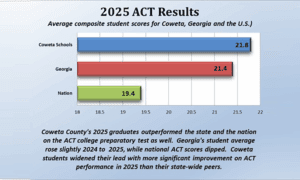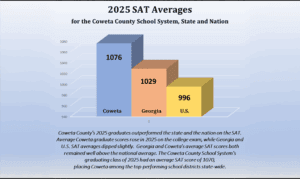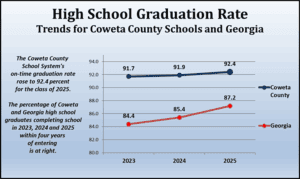The 2013 SAT scores are in and Coweta County’s high schools outscored the state average. Coweta’s composite average of 1,475 points on the college entrance exam was 23 points above the state average of 1,452.
“The average scores for each of Coweta County’s three high schools were above the state average in 2013, and Coweta’s high schools outscored national averages in some instances,” said school system spokesman Dean Jackson.
Northgate High School students scored 1,501 while Newnan High School students scored 1,473 and East Coweta High School students scored 1,457.
A perfect score on the SAT verbal, math and writing tests is a combined 2,400.
On the verbal section of the exam, Northgate High School and Newnan High School’s averages were above the national verbal score. Northgate High also outscored the national average overall, with a composite average score of 1,501 compared to the national average of 1,498 in 2013, Jackson said.
“The Coweta County School System has made a continuous effort to provide students with multiple, advanced academic opportunities throughout their school career, in early grades and at the high school level, and that continues to be seen in student performance on the SAT,” said Coweta Schools Superintendent Dr. Steve Barker.
Georgia students are often shown to score lower than a number of other states in the SAT. But there is more to the story when it comes to the SAT. Unlike many other states that encourage only the highest performing students to take the SAT, Georgia does encourage students to do so. And that encouragement can come with a price.
State school Superintendent John Barge said 75 percent of Georgia’s 2013 senior class took the SAT, more than 72,000 students, compared to the national participation rate of 43 percent. Georgia has the ninth highest participation rate in the nation. States with higher participation rates typically see lower average scores on the test and often see dips when the number of students taking the exam increases, Barge said.
“It is common for states that have high participation to have lower mean scores compared to states that have a very low participation rate. Media and others often rank states, districts and schools on the basis of SAT scores despite repeated warnings that such rankings are invalid,” said Barge. “The SAT is a strong indicator of trends in the college-bound population, but it should never be used alone for such comparisons because demographics and other non-school factors can have a significant effect on scores. If ranked, schools and states that encourage students to apply to college may be penalized because scores tend to decline with a rise in percentage of test-takers.”












Leave a Comment
You must be logged in to post a comment.